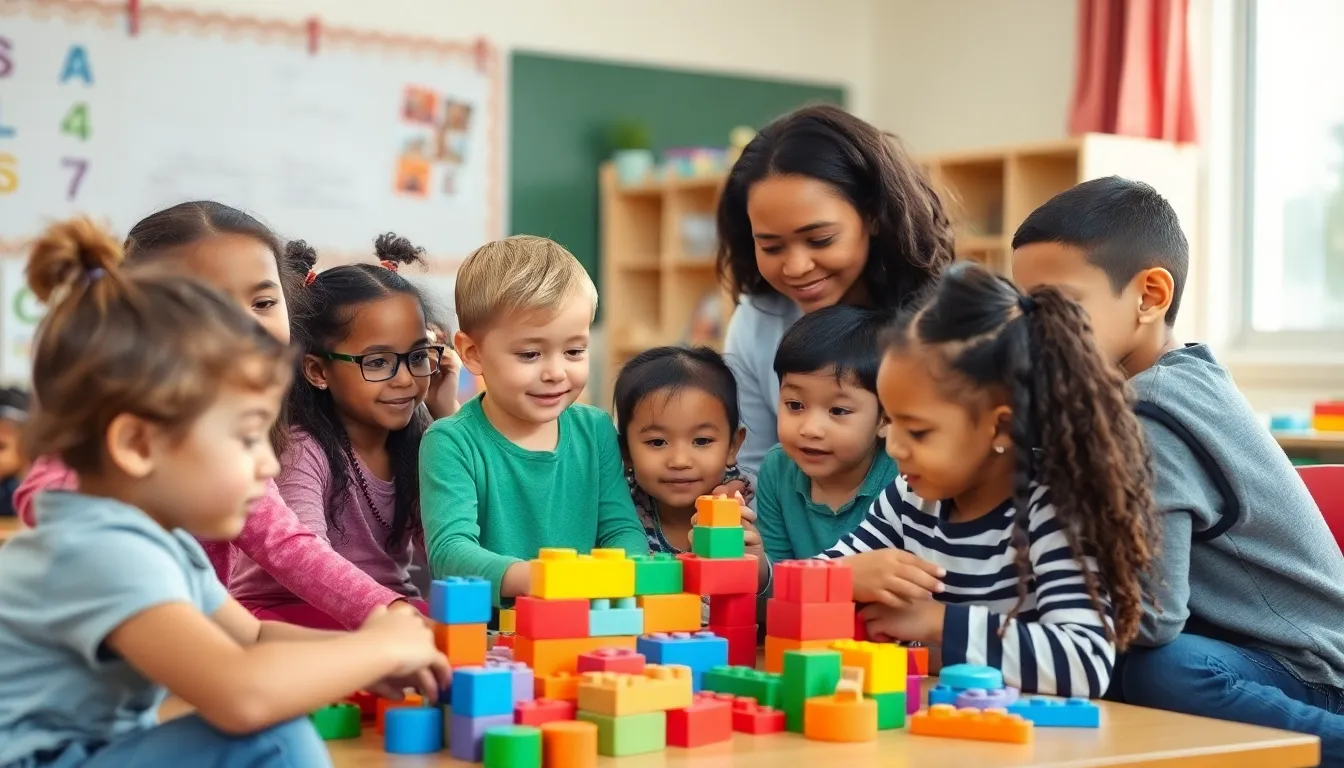When it comes to raising kids, it’s like building a house—without the right scaffolding, things can get a little wobbly. Scaffolding child development is all about providing the support kids need to reach new heights. Think of it as the safety net that helps them navigate the tricky terrain of learning and growing, all while keeping their sense of adventure intact.
Table of Contents
ToggleUnderstanding Scaffolding Child Development
Scaffolding plays a crucial role in child development. This process involves providing supportive structures that aid children as they learn and grow.
Definition of Scaffolding
Scaffolding refers to the temporary assistance offered to children as they master new skills. This technique stems from Vygotsky’s theory, emphasizing the importance of social interaction in learning. Importantly, it includes tailored instruction, guidance, and feedback designed to suit individual needs. As children progress, the support gradually decreases, encouraging independence. Effective scaffolding allows children to tackle challenges just beyond their current abilities, fostering confidence and resilience.
Importance of Scaffolding in Education
Scaffolding significantly enhances educational experiences. Teachers and caregivers can create an environment where children feel secure enough to explore and learn. Educators often use various strategies to facilitate this support, such as modeling tasks, providing prompts, and encouraging problem-solving. Research shows that children exposed to scaffolding develop critical thinking skills and higher academic performance. Moreover, this method promotes a sense of agency, allowing children to take ownership of their learning journeys. Scaffolding ultimately connects children with the concepts they encounter, solidifying their understanding and abilities.
Techniques for Effective Scaffolding

Effective scaffolding techniques strengthen children’s learning experiences. These strategies promote independence while nurturing a supportive environment.
The Role of Questions
Questions drive children’s curiosity and encourage deeper thinking. By asking open-ended questions, educators stimulate discussion and exploration. Questions can guide children to think critically about their approaches and outcomes. Additionally, probing questions help children articulate their reasoning and clarify misunderstandings. Encouraging them to ask their own questions fosters active engagement in the learning process. Tailoring questions to individual children’s interests makes learning relevant and increases motivation. By incorporating a variety of questioning techniques, educators effectively facilitate a child’s understanding and prompt exploration of new concepts.
Providing Feedback
Feedback serves as a crucial element of scaffolding that enhances children’s learning. Timely feedback reinforces positive behaviors and corrects misconceptions effectively. Constructive feedback focuses on specific actions and strategies, helping children understand their strengths and areas for improvement. Encouraging children to reflect on their responses deepens their learning and self-awareness. Positive reinforcement boosts confidence and encourages persistence when faced with challenges. Educators foster a growth mindset by providing feedback that emphasizes effort and learning progress. Using actionable feedback will ultimately guide children toward becoming more independent learners, enhancing their overall development.
The Impact of Scaffolding on Learning Outcomes
Scaffolding significantly influences children’s learning outcomes by providing essential support during their developmental journey. This approach cultivates an environment conducive to growth and exploration.
Enhanced Problem-Solving Skills
Problem-solving skills noticeably improve when educators use scaffolding techniques. Guided discovery encourages children to think critically about challenges. For instance, when faced with a complex task, teachers may ask leading questions that prompt deeper analysis. This method fosters an exploratory mindset, enabling children to navigate obstacles independently. Engaging in such activities strengthens their ability to assess problems from multiple perspectives. Offering constructive feedback further helps children refine their approaches, leading to improved strategies and solutions. As a result, children become more adept at tackling real-world challenges and enhancing their cognitive capabilities.
Improved Confidence and Independence
Confidence levels rise as children receive appropriate scaffolding throughout their learning experiences. Positive reinforcement and support empower children to take risks while learning new skills. Gradually reducing assistance allows children to build a sense of mastery over tasks, fostering independence. With each successful attempt, they gain assurance in their abilities. For instance, when children tackle increasingly complex projects, they experience a sense of accomplishment that boosts their self-esteem. Educators play a crucial role by acknowledging efforts and celebrating achievements, creating a supportive atmosphere. This growth in confidence ultimately encourages children to pursue new challenges, further solidifying their learning.
Challenges in Implementing Scaffolding
Implementing scaffolding in child development presents various challenges. Recognizing individual needs proves complex, as children differ significantly in their learning styles and paces.
Identifying Individual Needs
Determining a child’s specific requirements demands careful observation and assessment. Educators must engage in ongoing evaluations to tailor support to each learner’s unique abilities. Varying backgrounds, interests, and experiences influence how children approach tasks. Skilled educators adapt their strategies based on these observations, ensuring no child feels overwhelmed or left behind. Frequent communication with parents enriches understanding of the child’s experiences, allowing for enhanced support. Creating individualized plans encourages effective scaffolding that promotes engagement and success.
Balancing Support and Independence
Finding the right balance between support and independence is crucial. Over-supporting can hinder a child’s ability to solve problems independently. Gradually reducing assistance encourages self-reliance, fostering confidence in their skills. Educators use strategic questioning to guide children without providing direct answers. This method stimulates critical thinking and promotes a sense of ownership over the learning process. Establishing milestones helps track progress, allowing timely adjustments to support. Encouraging exploration minimizes anxiety and cultivates resilience, essential traits for lifelong learning.
Scaffolding child development is a vital process that empowers children to learn and grow effectively. By providing tailored support and gradually stepping back, educators help children build confidence and independence. This approach not only enhances cognitive skills but also fosters a sense of agency, encouraging children to take ownership of their learning journey.
Implementing effective scaffolding techniques requires careful observation and an understanding of each child’s unique needs. Striking the right balance between support and independence is crucial for nurturing problem-solving abilities. As children navigate challenges with the right guidance, they develop resilience and a lifelong love for learning that will serve them well in the future.




